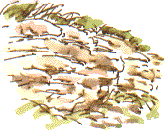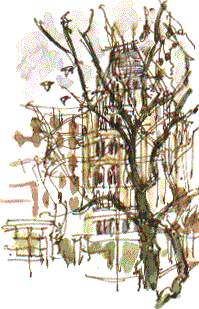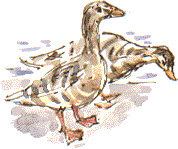Nature Diary Rocks History Gallery Links Home Page  THE LONDON TRAIN climbs a Jurassic scarp after its stop at Grantham station. A flaggy creamy-coloured limestone is exposed in the railway cutting. It's known as oolite because it's made up of tiny round pellets that resemble fish eggs ('oo-', as in oology, the study of eggs). It was laid down in a shallow tropical sea some 150 million years ago, when ichthyosaurs and plesiosaurs swam in the seas and sauropod dinosaurs walked on land.
THE LONDON TRAIN climbs a Jurassic scarp after its stop at Grantham station. A flaggy creamy-coloured limestone is exposed in the railway cutting. It's known as oolite because it's made up of tiny round pellets that resemble fish eggs ('oo-', as in oology, the study of eggs). It was laid down in a shallow tropical sea some 150 million years ago, when ichthyosaurs and plesiosaurs swam in the seas and sauropod dinosaurs walked on land.
From our room there's a view across the traffic lights of the west end of the building, seen through the branches of a London Plane, it's branches hung with golf-ball sized fruits. Leaves similar to those of the plane tree have been found fossilised alongside some of the later dinosaurs. The pillars of the railings in front of the museum are themselves made of Jurassic limestone; oolitic Portland Stone from Dorset.
The Serpentine From a table in the cafe in Hyde Park we watch Canada Geese, Black-headed Gulls and Coot on the Serpentine lake. Out of a hundred or more gulls only two have begun to moult to show their the chocolate brown hoods. Three drake Mallards half-heartedly chase a female. A pair of Great-crested Grebes are head-wagging.
From a table in the cafe in Hyde Park we watch Canada Geese, Black-headed Gulls and Coot on the Serpentine lake. Out of a hundred or more gulls only two have begun to moult to show their the chocolate brown hoods. Three drake Mallards half-heartedly chase a female. A pair of Great-crested Grebes are head-wagging.
To the eastern side of the top end of the Serpentine, known as the Long Water, there is a gentle slope dotted with ancient-looking Sweet Chestnuts. Some appear to have died back at the top, others look more as if they have been lopped. New shoots grow from lower down the tree, which then appears to grow multiple trunks, while the original trunk decays at the centre.
The Museum by NightLater that evening we're walking back to the hotel along Cromwell Road, opposite the illuminated facade of the Natural History Museum. With my interest in the night sky I'm not a great fan of illuminated buildings, but I have to admit that it looks magnificent, a piece of Gothick science fiction. White light picks out the bluish tiles and creamy bricks, with yellow lights in the turrets. The museum appears to be the length of the Titanic, sailing sedately through South Kensington. It has the power and authority of a cathedral, but, in this light, the insubstantial glittery magic of a Disney castle. Various beasts, extinct and living, are picked out in terra-cotta sculptures on the facade. The twin towers stand like Saturn rockets primed for take-off.It seems a symbol of intellectual confidence and endeavour. In a down to earth way this Victorian institution is dedicated to our continuing quest make sense of our origins in the universe, to catalogue our fellow creatures on this planet, before we wipe them out. To answer the questions of where we came from and, more alarmingly, where we might be going. I turn back to take one last look. It has just gone 11 o'clock and, in an instant, all the lights have gone out. Within seconds the building has reverted to a dark brooding silhouette. It has become solid and corporeal once again - just an immense pile of baked clay. It reminds me of the story of Cinderella.
|

 The hotel we've booked overlooks the Natural History Museum, South Kensington, where in 1958, as a seven year old, I first met up with the sauropod dinosaurs. At the time I was gripped with enthusiasm for dinosaurs, an enthusiasm that has stayed with me. I remember people were sitting making pencil or charcoal sketches of the skeletons. It occurred to me that if I was drawing dinosaurs I'd prefer to be sketching the real live version.
The hotel we've booked overlooks the Natural History Museum, South Kensington, where in 1958, as a seven year old, I first met up with the sauropod dinosaurs. At the time I was gripped with enthusiasm for dinosaurs, an enthusiasm that has stayed with me. I remember people were sitting making pencil or charcoal sketches of the skeletons. It occurred to me that if I was drawing dinosaurs I'd prefer to be sketching the real live version.
 Wild Grey Lags breed in Scotland, these will be feral birds.
Wild Grey Lags breed in Scotland, these will be feral birds.